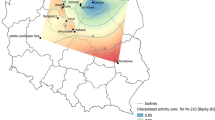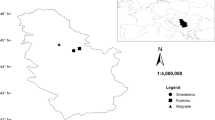Abstract
The aim of this study was to determine elemental composition of sap-feeding insects inhabiting various parts of the Ni hyperaccumulating plant Berkheya coddii Roessl., the endemic species of ultramafic outcrops in Mpumalanga, South Africa. Three species were examined: the aphid Protaphis pseudocardui (Aphididae), abundant on young leaves; the mealybug Orthesia sp. (Ortheziidae) colonizing underground parts of this plant, and the bug Norialsus berkheyae (Cixiidae) living on young shoots. Maps of Ni, K, Ca, Zn, and Fe for selected body areas of these species were generated using Dynamic Analysis method on the basis of particle-induced X-ray emission (micro-PIXE) and proton backscattering (BS) measurements. Atomic absorption spectrometry was used to determine Ni, Zn, Cu, Fe contents in the B. coddii organs, in some sap-feeding insect species including these mentioned above, and in the assassin bug hunting on Chrysolina pardalina, a monophagous beetle of B. coddii. Bioaccumulation factor for Ni in the examined species was below 0.05, and much higher for other metals (Zn ≥ 2; Fe ≤ 5). Ni distribution within body was species-dependent. It was the highest in the antennae of P. pseudocardui, in the head of Orthesia sp. and in the metathorax of N. berkheyae. Distribution patterns of other metals were different among examined species. Ca was recorded mainly in peripheral parts of the body in all species. Zn showed similar distribution to Ni. Fe distribution was similar to Ni only in the mealybugs. Uneven concentrations of metals within selected body regions indicated their relations with specific organs. Analysis of Ni transfer to higher trophic levels was done on the basis of two food nets: B. coddii—C. pardalina—Rhinocoris neavii and B. coddii—P. pseudocardui—Polyrhachis ant and led to the conclusion that the role of sap-feeding insects in Ni transfer was marginal.



Similar content being viewed by others

References
Augustyniak M, Mesjasz-Przybyłowicz J, Nakonieczny M, Dybowska M, Przybyłowicz W, Migula P (2002) Food relations between Chrysolina pardalina and Berkheya coddii–a nickel hyperaccumulator from South African ultramafic outcrops. FEB-Fresenius Environ Bull 11:85–90
Augustyniak M, Migula P (2000) Body burden with metals and detoxifying abilities of the grasshopper—Chorthippus brunneus (Thunberg) from industrially polluted areas. In: Merkert B, Friese K (eds) Heavy metals in environment. Elsevier, Amsterdam, pp 423–454
Boyd RS, Martens SN (1999) Aphids are unaffected by the elemental defence of the nickel hyperaccumulator Streptanthus polygaloides (Brassicaceae). Chemoecology 9:1–7
Boyd RS (2004) Ecology of metal hyperaccumulation. New Phytol 162:563–567
Boyd RS, Davis MA, Wall MA, Balkwill K (2006a) Metal concentrations of insects associated with the South African Ni hyperaccumulator Berkheya coddii (Asteraceae). Insect Sci 13:85–102
Boyd RS, Davis MA, Wall MA, Tanguy J (2006b) Nickel levels in arthropods associated with Ni hyperaccumulator plants from an ultramafic site in New Caledonia. Insect Sci 13:271–277
Crawford LA, Hodkinson ID, Lepp NW (1995) The effects of elevated host-plant cadmium and copper on the performance of the aphid Aphis fabae (Homoptera: Aphididae). J Appl Ecol 32:528–535
Dadd RH (1985) Nutrition: organisms. In: Kerkut GA, Gilbert LI (eds) Comprehensive insect physiology, biochemistry and pharmacology, vol 4. Pergamon Press, Oxford pp 313–390
Ernst WHO, Schat H, Verkleij JAC (1990) Evolutionary biology of metal resistance in Silene vulgaris. Evol Trends Plants 4:45–51
Hopkin SP (1989) Ecophysiology of metals in terrestrial invertebrates. Elsevier, New York
Mesjasz-Przybyłowicz J, Przybyłowicz W, Ostachowicz B, Augustyniak M, Nakonieczny M, Migula P (2002) Trace elements in the chrysomelid beetle (Chrysolina pardalina) and its Ni-hyperaccumulating host-plant (Berkheya coddii). FEB-Fresenius Environ Bull 11:78–84
Mesjasz-Przybyłowicz J, Przybyłowicz WJ (2001) Phytophagous insects associated with the nickel hyperaccumulating plant—Berkheya coddii (Asteraceae) in Mpumalanga, South Africa. S Afr J Sci 97:596–598
Migula P (1996) Trace metals in animals: an overview on essentiality transport, accumulation and adaptive mechanisms. Biol Bull Poznań 33:9–13
Migula P, Przybyłowicz W, Mesjasz-Przybyłowicz J, Nakonieczny M, Augustyniak M Głowacka E, Tarnawska M (2005) Energy budgets and nickel mapping in two coleopterans (Holcolaccus sp.n. and Chrysolina pardalina) feeders of Ni hyperaccumulator Berkheya coddii. SETAC. Europe 15th Annual Meeting Abstr. Book MO6–1/3, 26
Millar IM (1990) The aphids (Homoptera: Aphidoidea) of South Africa. Ent Memoir. Republic of South-Africa, Dept Agricultural Dev. 78, 105 pp
Millar IM (2002) Mealybug genera (Hemiptera: Pseudococcidae) of South Africa: identification and review. Afr entomol 10:185–233
Morrey DR, Balkwill K, Balkwill MJ (1989) Studies on serpentine flora—preliminary analyses of soils and vegetation associated with serpentinite rock formations in the Southeastern Transvaal. S Afr J Bot 55:171–177
Nichol H, Law JH, Winzerling JJ (2002) Iron metabolism in insects. Annu Rev Entomol 47:535–559
Phipps T, Tank SL, Wirtz J, Brewer L, Coyner A, Ortego LS, Fairbrother A (2002) Essentiality of nickel and homeostatic mechanisms for its regulation in terrestrial organisms. Environ Rev Dossiers Environ 10:209–261
Przybyłowicz WJ, Mesjasz-Przybyłowicz J, Pineda CA, Churms CL, Springhorn KA, Prozesky VM (1999) Biological applications of the NAC nuclear microprobe. X-ray Spectrom 28:237–243
Przybyłowicz W, Mesjasz Przybyłowicz J, Migula P, Głowacka E, Nakonieczny M, Augustyniak M (2003) Functional analysis of metals distribution in organs of the beetle Chrysolina pardalina exposed to excess of nickel by Micro-PIXE. Nucl Instr and Meth B 210:343–348
Przybyłowicz WJ, Mesjasz-Przybyłowicz J, Migula P, Turnau K, Nakonieczny M, Augustyniak M, Głowacka E (2004) Elemental microanalysis in ecophysiology using ion microbeam. Nucl Instr and Meth B 219–220:57–66
Reeves RD, Baker AJM (2000) Metal-accumulating plants. In: Raskin I, Ensley BD (eds) Phytoremediation of toxic metals: using plants to clean up the environment. Wiley, New York, pp 193–229
Ryan CG, van Achterbergh E, Yeats CJ, Drieberg SL, Mark G, McInnes BM, Win TT, Cripps G, Suter GF (2002) Quantitative, high sensitivity, high resolution, nuclear microprobe imaging of fluids, melts and minerals. Nucl Instr and Meth B 188:18–27
Smith S, Balkwill K, Willamson S (2001) Compositae on serpentine in the Barberton Greenstone Belt, South Africa. S Afr J Sci 97(2):518–520
Szwedo J (2005) Norialsus berkheyae n.sp. from South Africa (Hemiptera: Fulgoromorpha: Cixiidae)—planthopper from Berkheya coddii (Asteraceae), nickel hyperaccumulating plant. Genus 16:313–323
Vijver MAG, van Gestel CAM, Lanno RP, van Straalen NM, Peijneburg WGM (2004) Internal metal sequestration and its ecotoxicological relevance. Env Sci Technol 38:4705–4712
Acknowledgments
This study forms part of the joint South African–Polish cooperation project “Relations between South-African indigenous plant Berkheya coddii and its natural consumers for metal bioremediation purposes” supported by South African National Research Foundation and Polish State Ministry of Science and Higher Education. Mpumalanga Parks Boards and SAPPI Forestry are acknowledged for permission to access the sites and for all assistance.
Author information
Authors and Affiliations
Corresponding author
Rights and permissions
About this article
Cite this article
Migula, P., Przybyłowicz, W.J., Mesjasz-Przybyłowicz, J. et al. Micro-PIXE studies of elemental distribution in sap-feeding insects associated with Ni hyperaccumulator, Berkheya coddii . Plant Soil 293, 197–207 (2007). https://doi.org/10.1007/s11104-007-9231-7
Received:
Accepted:
Published:
Issue Date:
DOI: https://doi.org/10.1007/s11104-007-9231-7



